马上注册,结交更多好友,享用更多功能,让你轻松玩转社区。
您需要 登录 才可以下载或查看,没有账号?立即注册

×
《Materials for Low-Temperature Fuel Cells》
低温燃料电池材料
编辑:
Dr. Bradley Ladewig
Monash University
Department of Chemical Engin.
Prof. San P. Jiang
Curtin University
Department of Chemical Engineering &
Fuels and Energy Technology Institute
Prof. Yushan Yan
University of Delaware
Department of Chemical and Biomolecular
Engineering
出版社:Wiley
出版时间:2015年
《Materials for Low-Temperature Fuel Cells》
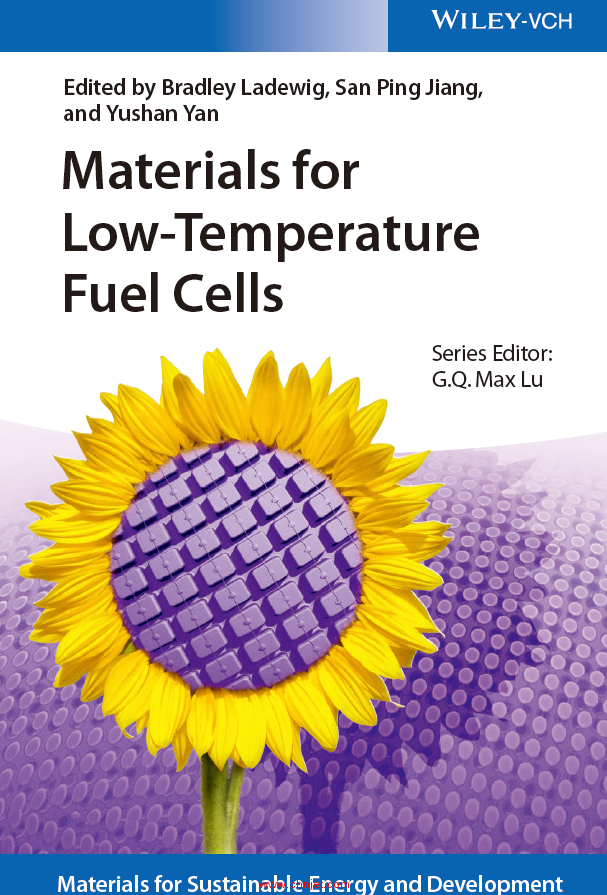
《Materials for Low-Temperature Fuel Cells》
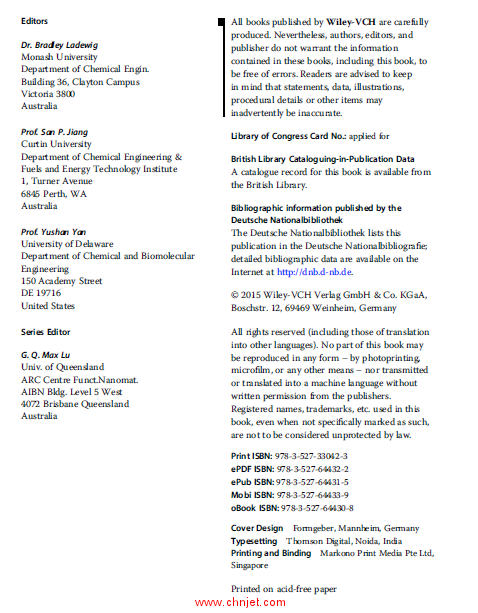
《Materials for Low-Temperature Fuel Cells》
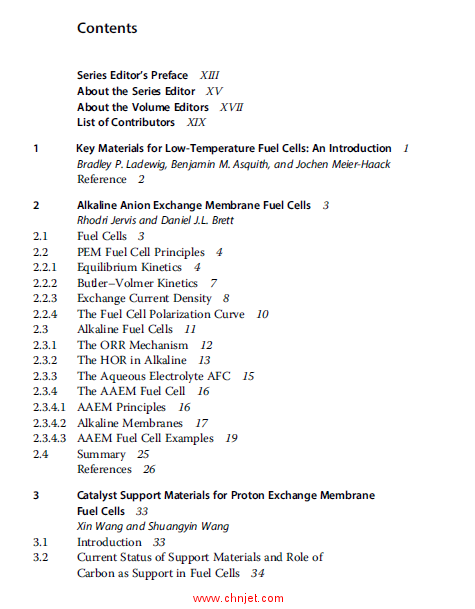
《Materials for Low-Temperature Fuel Cells》
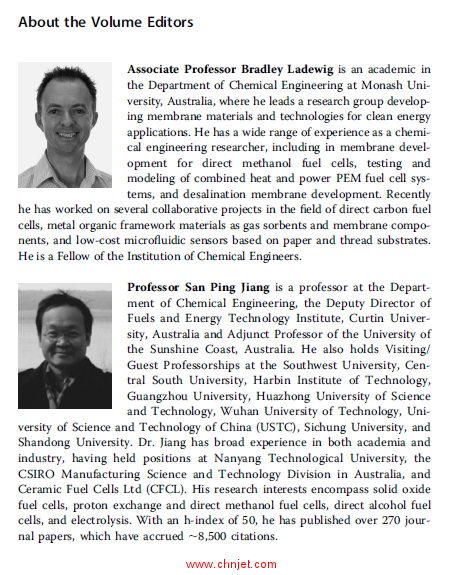
《Materials for Low-Temperature Fuel Cells》
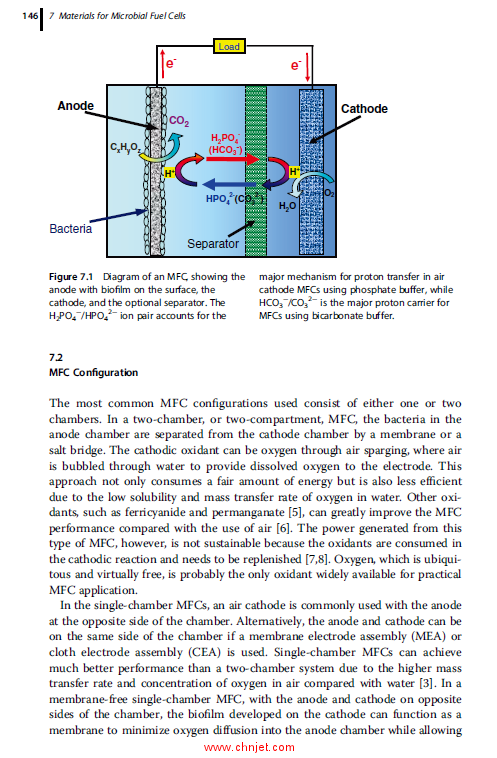
目录
Series Editor’s Preface XIII
About the Series Editor XV
About the Volume Editors XVII
List of Contributors XIX
1 Key Materials for Low-Temperature Fuel Cells: An Introduction 1
Bradley P. Ladewig, Benjamin M. Asquith, and Jochen Meier-Haack
Reference 2
2 Alkaline Anion Exchange Membrane Fuel Cells 3
Rhodri Jervis and Daniel J.L. Brett
2.1 Fuel Cells 3
2.2 PEM Fuel Cell Principles 4
2.2.1 Equilibrium Kinetics 4
2.2.2 Butler–Volmer Kinetics 7
2.2.3 Exchange Current Density 8
2.2.4 The Fuel Cell Polarization Curve 10
2.3 Alkaline Fuel Cells 11
2.3.1 The ORR Mechanism 12
2.3.2 The HOR in Alkaline 13
2.3.3 The Aqueous Electrolyte AFC 15
2.3.4 The AAEM Fuel Cell 16
2.3.4.1 AAEM Principles 16
2.3.4.2 Alkaline Membranes 17
2.3.4.3 AAEM Fuel Cell Examples 19
2.4 Summary 25
References 26
3 Catalyst Support Materials for Proton Exchange Membrane
Fuel Cells 33
Xin Wang and Shuangyin Wang
3.1 Introduction 33
3.2 Current Status of Support Materials and Role of
Carbon as Support in Fuel Cells 34
VII
3.3 Novel Carbon Materials as Electrocatalyst Support for Fuel Cells 35
3.3.1 Mesoporous Carbon as Support Materials for Fuel Cells 35
3.3.2 Graphite Nanofibers as Support Materials for Fuel Cells 39
3.3.3 Carbon Nanotubes as Support Materials for Fuel Cells 42
3.3.4 Graphene as Support Materials for Fuel Cells 49
3.3.5 Nitrogen-Doped Carbon Materials 52
3.4 Conductive Metal Oxide as Support Materials 54
3.5 Metal Carbides and Metal Nitrides as Catalyst Supports 56
3.6 Conducting Polymer as Support Materials for Fuel Cells 57
3.7 Conducting Polymer-Grafted Carbon Materials 58
3.8 3M Nanostructured Thin Film as Support Materials for Fuel Cells 59
3.9 Summary and Outlook 60
References 61
4 Anode Catalysts for Low-Temperature Direct Alcohol Fuel Cells 69
Wenzhen Li
4.1 Introduction 69
4.2 Anode Catalysts for Direct Methanol Fuel Cells: Improved Performance
of Binary and Ternary Catalysts 71
4.2.1 Principles of Direct Methanol Fuel Cells 71
4.2.2 Reaction Mechanisms and Catalysts for Methanol Electrooxidation 71
4.3 Anode Catalysts for Direct Ethanol Fuel Cells: Break C-C Bond to
Achieve Complete 12-Electron-Transfer Oxidation 73
4.3.1 Principles of PEM-Direct Ethanol Fuel Cells 74
4.3.2 Reaction Mechanisms and Catalysts for Ethanol Electrooxidation 74
4.3.3 Anion Exchange Membrane-Based Direct Ethanol Fuel Cells (AEMDEFCs)
77
4.3.4 Anode Catalysts for AEM-DEFCs 78
4.4 Anode Catalysts for Direct Polyol Fuel Cells (Ethylene Glycol, Glycerol):
Cogenerate Electricity and Valuable Chemicals Based on Anion
Exchange Membrane Platform 79
4.4.1 Overview of Electrooxidation of Polyols 79
4.4.2 Reaction Mechanisms and Catalysts for Ethylene Glycol
Electrooxidation 81
4.4.3 Reaction Mechanisms and Catalysts for Glycerol Electrooxidation 82
4.5 Synthetic Methods of Metal Electrocatalysts 84
4.5.1 Impregnation Method 86
4.5.2 Colloidal Method 87
4.5.2.1 Polyol Method 87
4.5.2.2 Organic-Phase Method 89
4.5.3 Microemulsion Method 90
4.5.4 Other Methods 90
4.6 Carbon Nanomaterials as Anode Catalyst Support 91
4.6.1 Carbon Nanotubes 91
4.6.2 Carbon Nanofibers 94
VIII Contents
4.6.3 Ordered Mesoporous Carbons 94
4.6.4 Graphene Sheets 95
4.7 Future Challenges and Opportunities 96
Acknowledgments 97
References 97
5 Membranes for Direct Methanol Fuel Cells 111
Bradley P. Ladewig, Benjamin M. Asquith, and Jochen Meier-Haack
5.1 Introduction 111
5.2 Basic Principles of Direct Methanol Fuel Cell Operation 111
5.3 Membranes for Direct Methanol Fuel Cells 112
5.3.1 Perfluorosulfonic Acid Membranes 113
5.3.2 Poly(styrene)-Based Electrolytes 114
5.3.3 Poly(arylene ether)-Type Polymers 115
5.3.4 Poly(ether ether) Ketone-Type Polymers 115
5.3.5 Polybenzimidazoles 116
5.3.6 Polysulfones and Polyethersulfones 116
5.3.7 Polyimides 117
5.3.8 Grafted Polymer Electrolyte Membranes 117
5.3.9 Block Copolymers 117
5.3.10 Composite Polymer Membranes 118
5.4 Membrane Properties Summary 118
5.5 Conclusions 120
References 120
6 Hydroxide Exchange Membranes and Ionomers 125
Shuang Gu, Junhua Wang, Bingzi Zhang, Robert B. Kaspar, and Yushan Yan
6.1 Introduction 125
6.1.1 Definition 125
6.1.2 Functions 125
6.1.3 Features 126
6.2 Requirements 126
6.2.1 High Hydroxide Conductivity 126
6.2.2 Excellent Chemical Stability 127
6.2.3 Sufficient Physical Stability 127
6.2.4 Controlled Solubility 128
6.2.5 Other Important Properties 128
6.3 Fabrications and Categories 128
6.3.1 Polymer Functionalization 128
6.3.2 Monomer Polymerization 129
6.3.3 Membrane Radiation Grafting 129
6.3.4 Reinforcement Methods 130
6.4 Structure and Properties of Cationic Functional Group 130
6.4.1 Quaternary Nitrogen-Based Cationic Functional Groups 130
6.4.1.1 Tetraalkyl Ammonium 130
Contents IX
6.4.1.2 Cycloalkyl Ammonium 132
6.4.1.3 Pyridinium 133
6.4.1.4 Guanidinium 133
6.4.1.5 Imidazolium 133
6.4.2 Quaternary Phosphorus-Based Cationic Functional Groups 134
6.5 Structure and Properties of Polymer Main Chain 134
6.5.1 Chemical Structure 134
6.5.1.1 Aromatic Main-Chain Polymers 137
6.5.1.2 Aliphatic Main-Chain Polymers 137
6.5.2 Sequential Structure 138
6.6 Structure and Properties of Chemical Cross-Linking 138
6.6.1 Chemical Structure 138
6.6.2 Physical Structure 140
6.7 Prospective 140
References 141
7 Materials for Microbial Fuel Cells 145
Yanzhen Fan and Hong Liu
7.1 Introduction 145
7.2 MFC Configuration 146
7.3 Anode Materials 147
7.3.1 Solid Carbon Materials 147
7.3.2 Granular Carbon Materials 148
7.3.3 Fiber Carbon Materials 148
7.3.4 Porous Carbon Materials 149
7.3.5 Modification of Anode Materials 149
7.4 Cathode 150
7.4.1 Catalyst Binders 151
7.4.2 Diffusion Layers 152
7.4.3 Current Collector 152
7.4.4 Cathode Fouling 152
7.4.5 Cathode Catalysts 153
7.4.5.1 Pt Cathode Modified with Nanomaterials 153
7.4.5.2 Cathode with Non-Pt Metal Catalyst 153
7.4.5.3 Carbon Cathodes 154
7.4.5.4 Conductive Polymers 155
7.4.5.5 Biocathodes 155
7.5 Separators 156
7.5.1 Cation Exchange Membranes 156
7.5.2 Anion Exchange Membranes 157
7.5.3 Biopolar Membranes 157
7.5.4 Filtration Membranes 157
7.5.5 Porous Fabrics 158
7.6 Outlook 158
References 160
X Contents
8 Bioelectrochemical Systems 167
Falk Harnisch and Korneel Rabaey
8.1 Bioelectrochemical Systems and Bioelectrocatalysis 167
8.2 On the Nature of Microbial Bioelectrocatalysis 167
8.3 Microbial Electron Transfer Mechanisms 169
8.3.1 Direct Electron Transfer 170
8.3.2 Mediated Electron Transfer (MET) 172
8.3.2.1 MET Based on Secondary Metabolites 173
8.3.2.2 MET Based on Primary Metabolites 173
8.4 From Physiology to Technology: Microbial Bioelectrochemical
Systems 173
8.5 Application Potential of BES Technology 175
8.6 Characterization of BESs and Microbial Bioelectrocatalysts 176
8.6.1 Electrochemical Methods 176
8.6.1.1 Polarization Curves 176
8.6.1.2 Voltammetry 177
8.6.1.3 Spectroelectrochemical and Further Techniques 178
8.6.2 Biological Methods 178
8.7 Conclusions 179
Acknowledgments 180
References 180
9 Materials for Microfluidic Fuel Cells 185
Seyed Ali Mousavi Shaegh and Nam-Trung Nguyen
9.1 Introduction 185
9.2 Fundamentals 187
9.3 Membraneless LFFC Designs and the Materials in Use 190
9.3.1 Flow Architecture and Fabrication of Flow-Over Design 197
9.3.2 Flow Architecture and Fabrication of Flow-Through Design 200
9.3.3 Flow Architecture and Fabrication of LFFC with Air-Breathing
Cathode 201
9.3.4 Performance Comparison 203
9.4 Fuel, Oxidant, and Electrolytes 203
9.4.1 Fuel Types 203
9.4.2 Oxidant Types 207
9.4.3 Electrolyte Types 208
9.5 Conclusions 210
References 211
10 Progress in Electrocatalysts for Direct Alcohol Fuel Cells 215
Luhua Jiang and Gongquan Sun
10.1 Introduction 215
10.2 Developing an Effective Method to Prepare Electrocatalysts 216
10.2.1 Carbon-Supported Platinum 216
10.2.2 Carbon-Supported Platinum–Ruthenium 217
Contents XI
10.3 Electrocatalysts for ORR 218
10.3.1 Highly Active PtFe Electrocatalysts for ORR 218
10.3.2 Methanol-Tolerant PtPd Electrocatalysts for ORR 219
10.4 Electrocatalysts for MOR 222
10.4.1 Composition Screening for Electrocatalysts toward MOR 222
10.4.2 Carbon-Supported Platinum–Ruthenium for MOR 223
10.5 Electrocatalysts for Ethanol Electrooxidation 226
10.5.1 Composition Screening for Electrocatalysts toward EOR 227
10.5.2 PtSn/C for Ethanol Electrooxidation 229
10.5.3 IrSn/C for Ethanol Electrooxidation 234
10.6 Conclusions 235
References 235
Index 241
专业书籍
下载地址:(回复后可见)
| ![]()